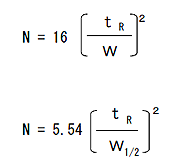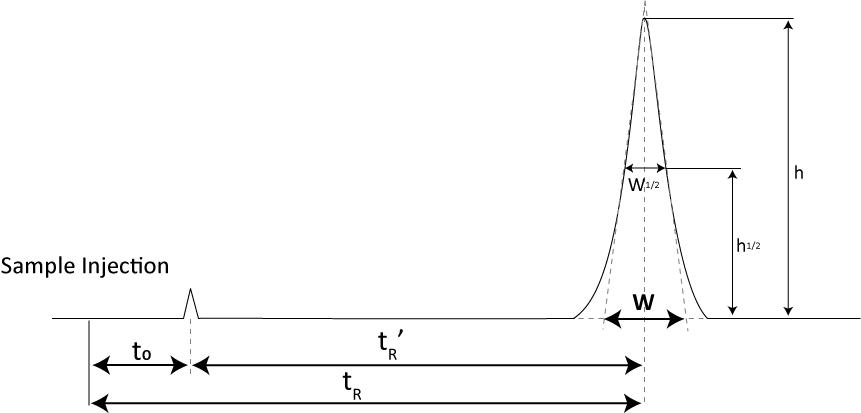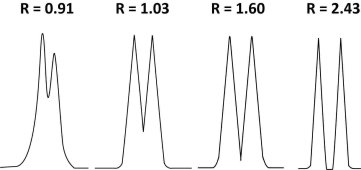Basics of Gas Chromatography
1-4 Fundamentals and Theory of Chromatography
1-4-1 Retention Time, Adjusted Retention Time, Retention Factor
The time between sample injection and detection of a particular substance is called the retention time of that substance. It is obtained by summing the time for which the substance was dissolved in the liquid phase (adjusted retention time) and the time during which the substrate moved through the column with the carrier gas (hold-up time). The hold-up time is obtained by injecting a compound (methane, air, etc.) that is not retained in the column and measuring its elution time. The retention factor is then calculated as the ratio of the adjusted retention time to the hold-up time. The carrier gas velocity affects both the retention time and adjusted retention time but does not affect the retention factor. In the same column at a given temperature, the retention factor is constant for each solute and is thus a useful parameter for peak identification.
Hold-Up Time (t0), Adjusted Holding Time (tR'), Retention Factor (k')

1-4-2 Number of Theoretical plates (N)

The chromatograms of two components eluting at identical intervals. However, only one of the two components has completely separated. The non-separation of the other component is attributable to performance differences between the columns selected for the analysis. Column performance is often described as the theoretical plates, which can be calculated as follows:

| N | : Number of Theoretical plates |
|---|---|
| tR | : Retention time |
| t0 | : Hold-up time |
| tR ' | : Adjusted retention time |
| W | : Peak width at baseline |
| W1/2 | : Peak width at 1/2 the peak height |
| h | : Peak height |
| h1/2 | : 1/2 of the peak height |

The larger the theoretical number of stages, the better is the column performance. A column with good performance will produce a small peak spread.
1-4-3 height equivalent of one theoretical plate (HETP)
HETP is the equivalent length (in mm) of one theoretical plate. The smaller the HETP, the better is the performance of the column. The HETP is calculated as
HETP = L / N
N: theoretical plates
L: column length (mm)
1-4-4 resolution (R)
The resolution R represents the separation of two adjacent peaks. Peaks with a separation of 1.5 or higher are fully separated. For two components, R is calculated as

| Rs | : Resolution |
|---|---|
| tR1,tR2 | : Retention times of components 1 and 2 (tR1 < tR2) |
| W1/2 1, W1/2 2 | : Peak widths at 1/2 the peak height 1 and 2 |



























